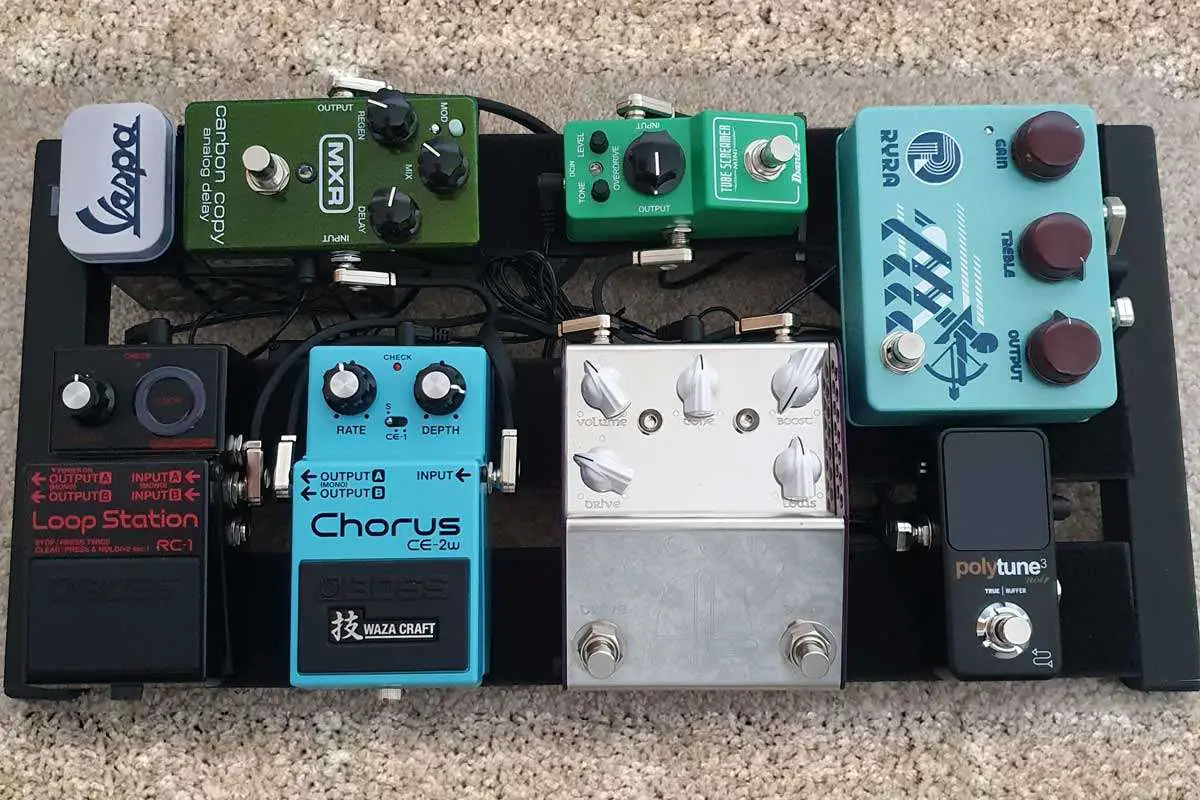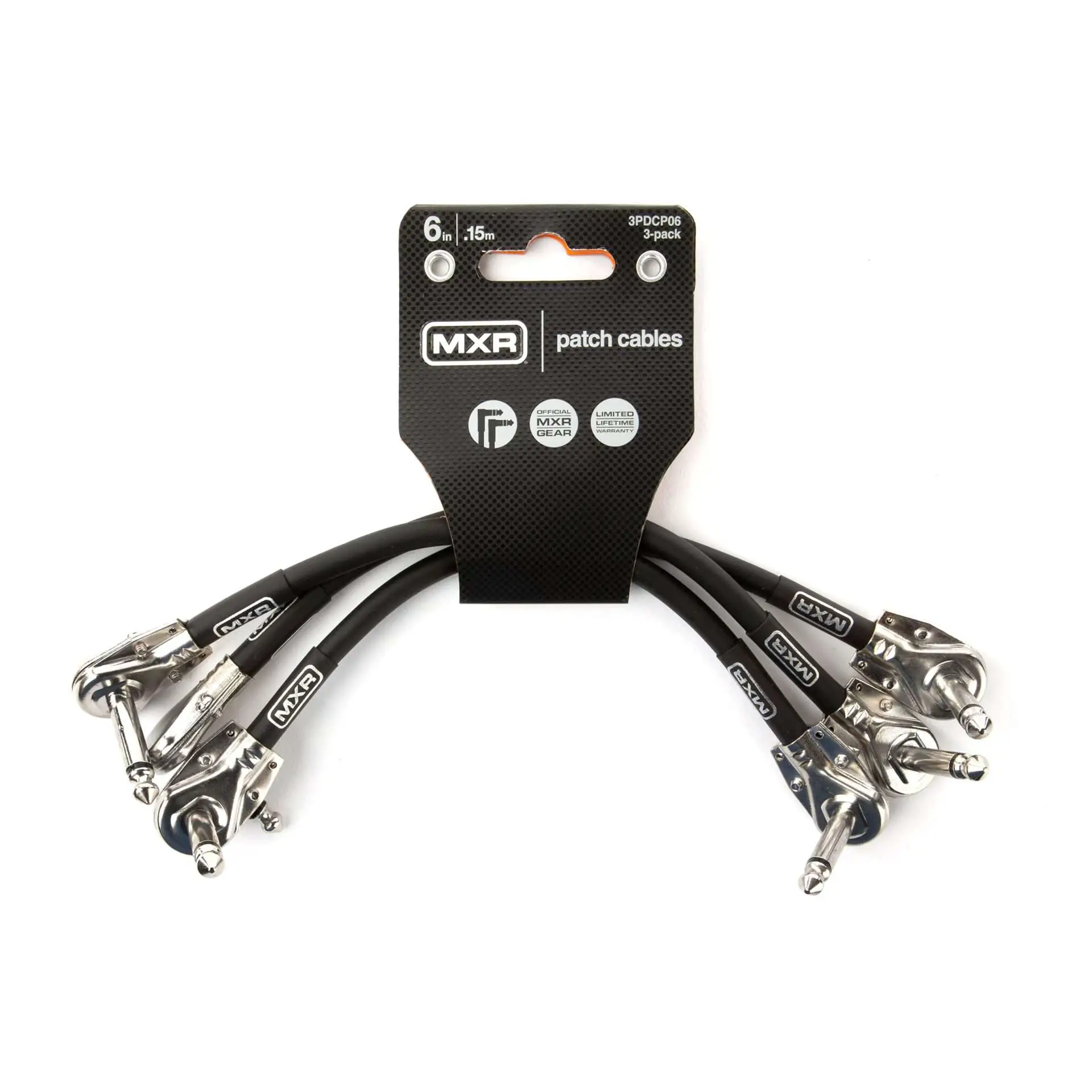Guitarists, whether they’re playing in their bedroom or on a stadium stage, rely on a variety of equipment to craft their tone. Among these, guitar patch cables play a fundamental role in connecting effects pedals, ensuring signal integrity, and maintaining the clarity of the guitar’s sound. These cables are short (3-12 inches) and typically used to interconnect guitar pedals within a pedalboard. The quality of patch cables can have a notable impact on the noise level and tone quality of the guitar signal chain. Here’s some of the best patch cables we’ve come across that work well without costing an arm and a leg.
When selecting patch cables, players must consider factors such as cable length, durability, and shielding. The length of the cable should be just enough to connect pedals while avoiding excess slack that can cause a tangled mess or signal loss. Durability is paramount, as the cables must withstand the rigors of repeated plugging and unplugging, as well as potential foot traffic. Shielding is also crucial, as it prevents interference that can degrade the guitar’s signal.
Our focus is on pinpointing the best guitar patch cables available that fulfill the needs of modern guitarists. These cables should ensure signal clarity, withstand regular use, and preserve the true sound of the guitar and pedals. After extensive research and testing, we have identified a selection of patch cables that stand out from the rest, offering reliable performance and superior tone.

Top Guitar Patch Cables
In our quest for the perfect tone and a clutter-free pedalboard, we understand the significance of quality patch cables. They’re the unsung heroes that connect our pedals together while preserving the integrity of our sound. We’ve rigorously tested and compared various cables to bring you a selection that stands out for their durability, audio fidelity, and value. Whether you’re setting up your first board or looking to upgrade your current rig, our list is sure to feature a patch cable that resonates with your needs.
Ernie Ball Patch Cables

We’ve found these Ernie Ball Patch Cables to excel in maintaining the pure tone of our setup while providing a tidy pedalboard arrangement.
Pros
- Compact connectors effectively save space
- High-quality copper construction ensures durability
- The flat cable design minimizes clutter, enhancing pedalboard layout
- Available individually, in packs, and different sizes
Cons
- Premium price point compared to standard cables
- Flat design might feel awkward for certain connections
In the sea of accessories necessary for a clutter-free and efficient pedalboard, these Ernie Ball Patch Cables stand out. Their slim profile is a game-changer for us. We’re able to fit pedals closer together, thanks to the low-profile connectors and flat cable design.
These cables have become our go-to for reliability. The construction feels robust enough to withstand frequent plugging and unplugging. This durability eases our minds during both practice and performance.
Signal integrity is crucial to us, and it’s something these cables preserve exceptionally well. We appreciate the multiple layers of shielding that minimize any noise or interference. While the 3-inch length is convenient for most of our applications, we sometimes wish there were more length options for larger setups. Despite the cost being on the higher side, from our experience, the quality justifies the investment.
Donner Patch Cables

We think these Donner patch cables are a smart pick for any musician who wants to organize their pedalboard efficiently while maintaining a clean signal path.
Pros
- Low-profile right angle plugs free up pedalboard space
- Durable construction with a heat-resistant polyethylene dielectric
- High-quality sound transmission with low capacitance and noise rejection
- Available in 6 or 12 inch versions
Cons
- May be too short for some pedal configurations
- Limited color options only in black
- Potentially less flexible when trying to navigate complex pedal setups
Having just reorganized our pedalboard, we immediately noticed the space-saving design of these Donner patch cables. The low-profile pancake plugs enabled us to fit more pedals into a cramped space, giving us the opportunity to expand our sound range without needing a larger board.
In terms of build quality, it was apparent that these cables are meant to last. We’ve plugged and unplugged them numerous times during setup, and they’ve held up without showing signs of wear. The heavy-duty jacks coupled with the proprietary silver solder blend provided added assurance of their longevity.
Most importantly, the sound quality wasn’t compromised. We’ve used these cables with various pedals and found the high purity copper shielding effective at keeping any unwanted noise at bay. Our signal chain remained clear and true to the tone of our instruments, affirming Donner’s claims of delivering high-fidelity audio.
Amazon Basics Patch Cables

We believe these cables are a smart choice for guitarists seeking reliable connectivity without splurging on high-end options.
Pros
- Snug right-angle connectors optimize pedalboard space
- Effective shielding enhances signal clarity
- Solid build quality delivers dependable performance
- Generic but have thousands of positive reviews
Cons
- Bulkier jacks may limit pedal proximity
- Fixed 6-inch length might not fit all setups
- Lacks premium features of high-end cables
Indeed, these Amazon Basics cables left a solid impression during our test run. With their robust right-angle plugs, setting up a clutter-free pedalboard was a breeze. The audio signal remained crystal clear, suggesting that the oxygen-free copper does its job well in shielding against interference.
Even with constant plugging and unplugging, the connectors maintained their integrity, showcasing the cables’ durable build. It’s always refreshing to spot a product that combines budget-friendliness with quality performance.
On the flip side, we took minor issue with the jacks’ size, which could prevent pedals from sitting flush against one another. However, for most, these compact cables should suffice, especially if your rig is relatively static and won’t suffer from a bit of extra connector bulk.
For a musician who needs a no-frills solution for their home or practice space, these Amazon Basics cables are a splendid way to go. Their reliability didn’t go unnoticed, and for the price, finding a match could be quite the challenge.
MXR 6″ Patch Cables

We think these MXR patch cables are a trusted choice for any guitarist looking to maintain a clean signal chain.
Pros
- Remarkable sound clarity and preservation of tone
- Robust construction that handles frequent use
- Slim, right-angled connectors optimize pedalboard space
Cons
- Flat plugs may not fit all pedal jack layouts
- Some may prefer longer cables for more extensive setups
- The fixed length limits flexibility in pedal arrangement
When we hooked up our pedals with the MXR patch cables, the first thing that struck us was the undeniable sound fidelity. The pure tone flowed without any buzz or interference that can plague lesser cables. Its oxygen-free copper conductors and the spiral shield did a remarkable job blocking stray signals.
Durability is a given with these cables. We’ve bent and twisted them during setup, and they’ve consistently sprung back into their original shape. The PVC jacket isn’t just for flexibility; it also ensures these cables can take a beating on stage and in the studio.
The right-angle connectors are cleverly designed to keep the pedalboard neat and streamlined. They allow us to arrange our gear without any loose cables jutting out, maintaining a clean stage appearance and reducing the risk of accidental unplugs.
HONEST KIN Patch Trio

We found these cables to offer an upgrade in sound clarity and pedalboard neatness, which should delight both beginners and gigging pros.
Pros
- Clarity of tone with minimal signal interference
- Ideal length for a clean and organized pedalboard
- Flexible cable with durable, low-profile connectors
Cons
- Size of the jacks might crowd pedals with top-mount jacks
- The cables may feel a bit long for compact setups
- Limited to right-angle connections, which may not suit all layouts
In our experience, the HONEST KIN Guitar Patch Cables delivered a noticeable difference in sound quality. By reducing unwanted noise with their double shielding, our signal chain remained pure and uncolored. The gold-plated connectors, aside from providing that high fidelity signal, also gave us confidence in their durability.
When it comes to pedalboard real estate, these cables are a godsend. Their 12-inch length hits a sweet spot where excess cable doesn’t clutter the board, yet they’re long enough to connect pedals comfortably. The slim profile of the pancake connectors saved space and allowed us to fit more pedals in a limited area.
However, we noticed the size of the jacks might not be perfect for every setup. Pedals with top-mounted jacks could feel a bit cramped. While they are a tad long for compact pedal chains, we’d still prefer cables that err on the side of being too long than too short. Right-angle connectors are great for side-mount jacks but keep in mind they might not be the best for every situation.
Buying Guide
When selecting the best guitar patch cables, we consider several key features that ensure optimal performance and durability. Here are some factors that should guide your choice:
Cable Length
We choose cable length based on our setup. Short cables reduce clutter and signal loss, while longer cables offer more mobility. Here’s a guide for standard lengths:
- Short (6 inches to 1 foot): Ideal for connecting pedals that are close together.
- Medium (1 to 5 feet): Suitable for larger pedalboards or when a bit more reach is needed.
- Long (5 to 20 feet): For when we connect to gear that’s farther away, but keep in mind that longer lengths can introduce noise. These are more for connecting your instrument to your board or amplifier than individual pedals.
Connectors
Connectors are critical for a secure fit and signal integrity. We prefer:
- Straight: Best for cable ends that need to reach in the same direction.
- Angled: Helps with pedal connectivity and reduces space. Best for tight spaces.
Conductor Material
Conductivity affects signal clarity and tone. We generally see oxygen-free copper as a standard due to its excellent signal transmission properties.
Shielding
Shielding protects against interference from external sources. We look for:
- Spiral: Offers flexibility and good noise rejection.
- Braided: Provides better shielding but can be less flexible.
Durability
Our patch cables must withstand repeated use and movement. We consider:
| Feature | Benefit |
|---|---|
| Durable Jacketing | Protects the cable’s inner workings and extends life. |
| Reinforced Plugs | Reduces wear at connection points. |
| Strain Relief | Prevents cable damage when bent or twisted. |
Remember, the best patch cable is one that matches our needs without compromising on sound quality or build integrity.
